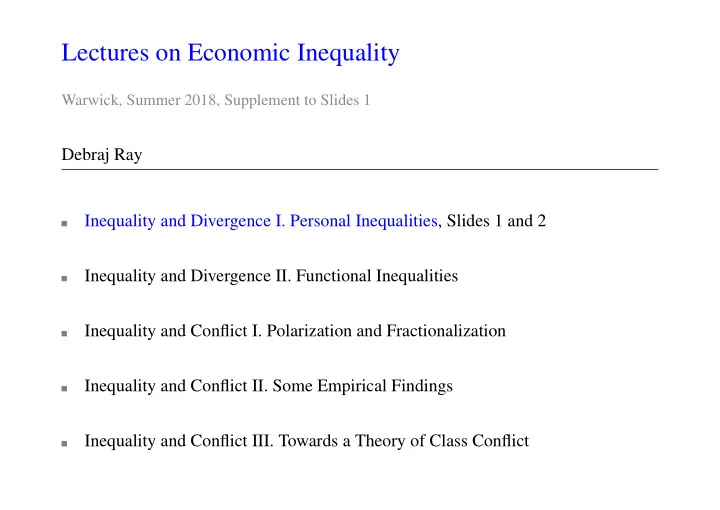

Lectures on Economic Inequality Warwick, Summer 2018, Supplement to Slides 1 Debraj Ray Inequality and Divergence I. Personal Inequalities, Slides 1 and 2 Inequality and Divergence II. Functional Inequalities Inequality and Conflict I. Polarization and Fractionalization Inequality and Conflict II. Some Empirical Findings Inequality and Conflict III. Towards a Theory of Class Conflict
Postscript on Return-Seeking Recall our question: What explains the high rates of return to the rich? Two broad groups of answers: The rich have access to better information on rates of return The rich have physical access to better rates of return.
Investing in Investment A theory of individual-specific r : Higher individual wealth ⇒ higher rate of return on it. More effort spent on gathering information.
Investing in Investment A theory of individual-specific r : Higher individual wealth ⇒ higher rate of return on it. More effort spent on gathering information. Compare/contrast with “efficiency wage” models: Deliberate investment in information yields the higher rate unlike nutrition-effiency, but similar to dynamic incentives Payoff is multiplicative (on r ) as opposed to additive other “efficiency-wage” models generate level effects
A Model of Investing in Investment Individuals with more financial wealth will spend more effort finding good rates of return on it. Simplest model of this: ∞ δ t c 1 − θ − 1 t ∑ , 1 − θ t = 0 where θ > 0, and c t = ( 1 + r t − 1 ) F t − 1 + w ( 1 − e t ) − F t , and r t = Ψ ( e t ) F : financial wealth, w : wage rate, and e : informational effort. Ψ concave.
Familiar Euler equation for choice of F t : � θ � c t + 1 = δ r t c t Slightly less familiar Euler equation for choice of e t : � θ � c t + 1 = δ F t w Ψ ′ ( e t ) . c t Proposition. Individuals with a higher ratio of F to w earn a higher rate of return, and grow faster, even if the effect on their savings rate is ambiguous. Proof. Combine the two Euler equations and definition of r to see that r t = F t w Ψ ′ ( e t ) = Ψ ( e t ) for all t . Now prove the proposition by contradiction. Note: s and r reinforce each other when θ < 1.
Or you can have your cake and eat it too. Consider c t = r t − 1 F t − 1 + w − z t − F t , where r t = Φ ( z t ) (e.g., paying an expert to do your research). Then Euler equation for z is given by � θ � c t + 1 t Φ ′ ( z t ) , = δ F c t Proposition. Those with higher F earn higher rates of return. PS: Contrast the two propositions.
Recommend
More recommend